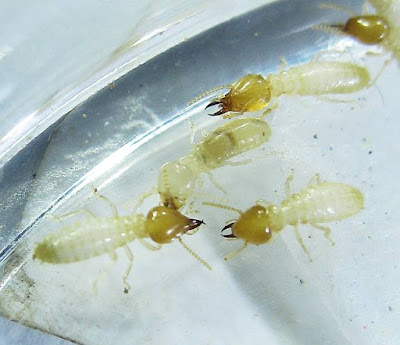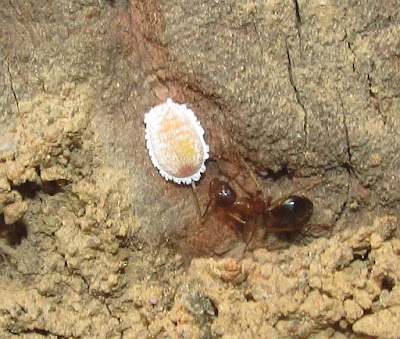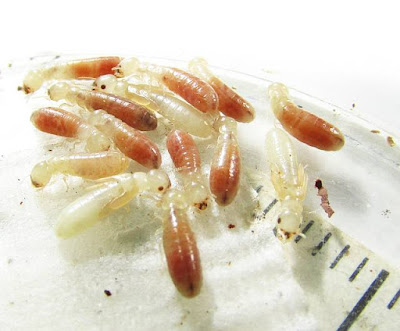Cryptotermes secundus are drywood termites. Initially I thought this was Cryptotermes dudleyi, as this species is native to this region (South Asia).
They both looks almost identical (macro view) but on closer examination, it is (I think) Cryptotermes secundus. The most obvious of this difference is that in C. dudleyi the head of the soldiers are lighter in coloration (yellowish) whereas in C. secundus it is brown. In termites coloration (intensity) tend to be more definitive than in ants. Also in C. dudleyi the mandibles are more heavily toothed extending from the base to more than two third the length of the mandibles.
(click on screen shots to enlarge)
That however is not true. They tend the nest, moving the droppings (aka frass) around: clearing their tunnels and cravens as well as sealing (using a thick sticky liquid they excrete, see image 'Figure 1' below) them to block any exposed openings (see 'Video 1' below); groom the king and queen, including the soldiers and one another (see 'Video 2' below). They also feed the king and queen (which stopped feeding themselves once the colony is a few months old and rely on the workers to feed them); feed the soldiers, and tend the eggs (gathering them and placing them together).
Figure 1. The top of the container housing a colony of Cryptotermes secundus. The workers of Cryptotermes secundus have sealed off the gap in the container cap with their sticky excrement.
Video 1: In this video you can see that the workers of drywood termites Cryptotermes secundus have worked to clear the nest area (which is at the bottom of container) of their frass and have sealed off (the 'outside') the area above with their frass.
Video 2: Workers of Cryptotermes secundus grooming each other
(click on video then click play to view)
No, (increase in the intensity of) "head butting" is not a way to determine who (which of the workers) get to be queen (i.e. the secondary or neotenic reproductive), it is just to signal (exhibition of stress). And also no, it is not head butting at all but vibrating (their clumsy way) their bodies (which most termites do, though most not as clumsily as drywood termites), as one of the avenues or means of termite communication, usually as some warning when there is danger or the nest is breeched. This is one reason termite exterminators in order to determine if there is an infestation will tap the (target) wood and listen for the sound of the termites vibrating their bodies.
In the video (second video below, 'video 4') this you can see the termites on being exposed to intense light (I needed it to video them) started to so claimed "head butting" (i.e. vibrating their bodies) and moved away when I shone a light to video tape them. Prior to this (first video directly below, 'video 3') they were all grouped together peacefully eating the wood below them, there was no so called "head butting" at all.
Video 3: Cryptotermes secundus peacefully feeding
when no light was shone on them
(click on video then click 'Play' button to view)
Video 4: They began vibrating (i.e. shaking their bodies) as a sign of some kind of communication (commonly as some kind of signal of danger to their nest mates) when I shone a light on them in order to video tape or record them.
(Click on video then click 'Play' button to view)
Soldier of Cryptotermes secundus with eggs and nymphs. Among termites, drywood termites (generally) have larger eggs and not just larger but longer (around three to four times larger). This is probably because the hatchings (nymphs) hatch into a low humidity environment and they are born (i.e. hatch) with more moisture in them.
Newly hatch larva or nymph and soldier of Cryptotermes secundus. The nymph is among the largest of newly hatched termites with a body that is particularly large, much larger (generally) than those newly hatch nymphs of many to most termites.
Nymphs or larvae of termites (unlike those of most ants) are independent (and self feeding), though in some cases they are extremely slow moving (especially newly hatched nymphs) and are (often but not all the time) carried to safety by the adult workers when there is danger in the confines of the nests and its passage ways (i.e. tunnels and cravens).
In drywood termites this is seldom done probably because they are so slow moving and also they live in dry wood and rarely have situations where the nest is breech in a major ways so they have not adapted to it. And if that does happen (the nest is severely breeched), essentially those of the members that are exposed are ultimately lost anyway, so any effort to save the brood by these exposed are pointless.
Unlike ants, worker termites' instinct when their nest is breeched is to flee. In ants only the callows and queens flee while the workers (some to most) will grab a brood (egg, larva or pupa) and flee with some workers (usually the major workers but in many cases, even the minor workers) rushing out to defend the nest. The workers will only repair the breech after it is secured, otherwise they just abandon that portion or area of their nest.
Soldier, eggs, newly hatched nymph, workers, queen
and third instar nymphs.
(click on video and click 'play' button to view)
See also:
Cryptotermes cynocephalusandDampwood termites
TaxonomyNo rank: cellular organisms
Superkingdom (Domain): Eukaryota
No rank: Opisthokonta
Kingdom: Metazoa
No rank: Eumetazoa
No rank (
Subkingdom): Bilateria
No rank (
Branch): Protostomia
No rank (
Infrakingdom): Ecdysozoa
No rank (
Superphylum): Panarthropoda
Phylum: Arthropoda
No rank (
Subphylum): Mandibulata
No rank: Pancrustacea
Subphylum (
Epiclass): Hexapoda
Class: Insecta
No rank (
Subclass): Dicondylia
Subclass (
Infraclass): Pterygota
Infraclass: Neoptera
No rank: Polyneoptera
No rank (
Superorder): Dictyoptera
Order: Blattodea
Superfamily: Blattoidea
(Suborder: Isoptera) (
this suborder/infra family/No rank appears to no longer be accepted as a taxonomy classification by most to nearly all taxonomy authorities, however I am a stubborn hold out, but what do I know)
No rank: Termitiodea
Family: Kalotermitidae
Subfamily: Cryptotermitinae
Genus: Cryptotermes
Species: secundus
Last Updated: 2022 09 15
First Posted: 2022 09 15
© 2009 – 2022 Quah. All rights reserved.
























































